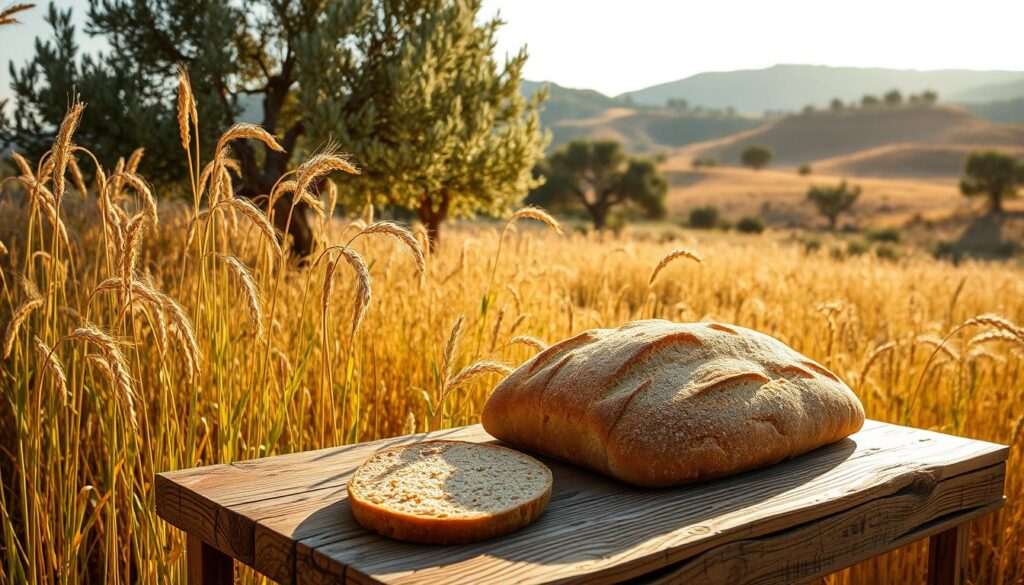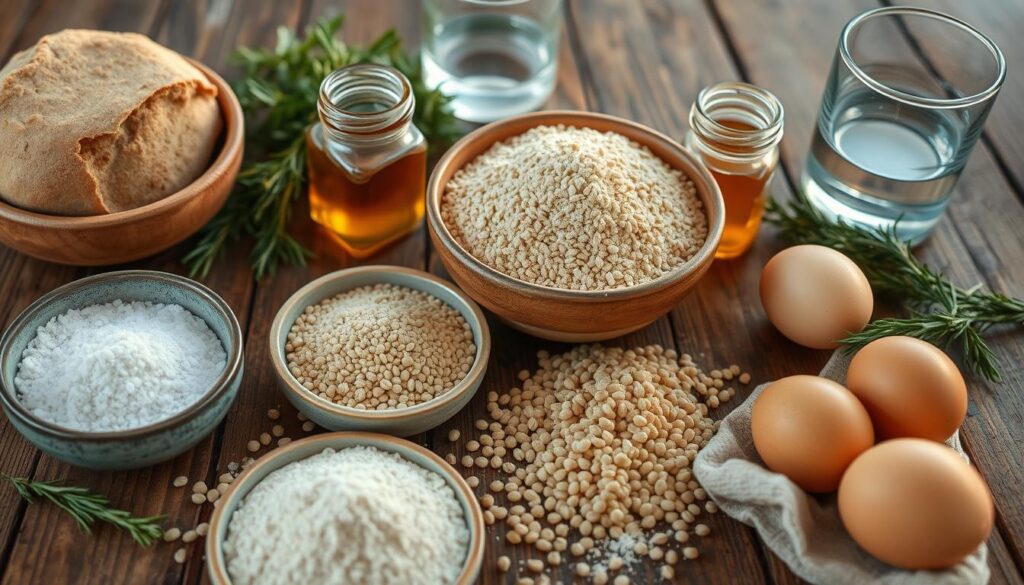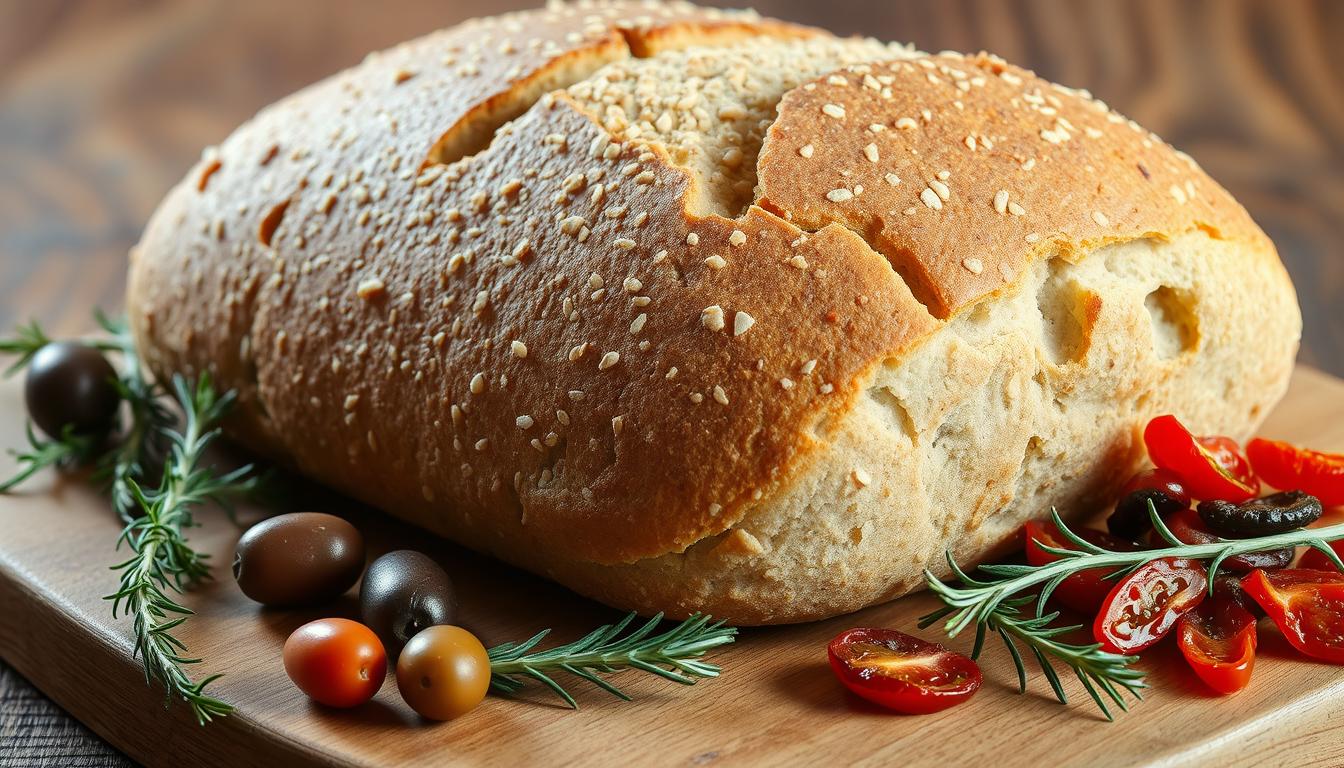Living with gluten sensitivity has made finding good bread tough. But then I found buckwheat bread. It’s a game-changer for those who follow a Mediterranean diet. This bread is not just a food; it’s a comfort for my body and soul.
Table of Contents
Understanding Buckwheat’s Ancient Origins and Modern Appeal
Buckwheat, an ancient grain, has been a key part of Mediterranean cuisine for centuries. It’s been grown for thousands of years. This crop is not just important historically; it’s also loved for its health benefits, making it great for healthy baking and mediterranean diet bread.
Historical Significance in Mediterranean Cuisine
Buckwheat isn’t actually a wheat. It’s a pseudocereal, used like a grain but with its own nutritional benefits. In the Mediterranean, it’s been a favorite for generations, used in many dishes and baked goods.
Nutritional Profile of Buckwheat Grain
Buckwheat is known for its nutritional value. As an ancient grain, it’s packed with high-quality protein, fiber, and vitamins like manganese and magnesium. This makes it a great choice for healthy baking.
Modern Popularity in Gluten-Free Diets
In recent years, buckwheat has become a hit as a gluten-free option. It’s perfect for those with gluten issues. Its use in mediterranean diet bread and other recipes has made it a favorite for health-conscious eaters.

“Buckwheat’s unique nutritional profile and gluten-free properties have made it a standout ingredient in the world of healthy baking and Mediterranean-inspired cuisine.”
Essential Ingredients for Perfect Buckwheat Bread
Making gluten-free buckwheat bread needs the right ingredients. Buckwheat flour is at the center, offering nutrients and a whole grain option. You can mix it with almond or oat flour for the best texture and rise.
Ingredients like xanthan gum or psyllium husk are key for gluten-free baking. They help the dough stick together and prevent crumbling. Yeast makes the bread light and airy, while salt adds flavor.
You can add seeds, nuts, or honey for extra nutrition and taste. It’s important to measure each ingredient carefully. Gluten-free baking needs the right mix for the perfect bread.
| Ingredient | Quantity |
|---|---|
| Buckwheat Flour | 2 cups (140 grams) |
| Ground Almonds | 1 cup (100 grams) |
| Xanthan Gum | 1 teaspoon |
| Instant Yeast | 1 tablespoon |
| Salt | 1 teaspoon |
| Water | 1 cup |
With the right mix of ingredients, you can make a tasty, gluten-free buckwheat bread. It’s both healthy and fulfilling.

The Science Behind Gluten-Free Buckwheat Baking
Baking tasty, sturdy high-fiber bread recipes needs a good grasp of plant-based baking science. Unlike wheat bread, which gets its structure from gluten, buckwheat bread uses other ingredients. These help it rise and have the right texture.
Role of Binding Agents
Without gluten, bakers use xanthan gum or psyllium husk in plant-based baking. These ingredients help the dough stick together. They also trap the air bubbles, making the bread light and fluffy.
Temperature and Moisture Control
Getting the right temperature and moisture is key for high-fiber bread recipes with buckwheat flour. Gluten-free doughs need more water because they’re drier. Watching the dough’s temperature and humidity is crucial for a soft, moist bread.
Fermentation Process
The fermentation stage is vital for buckwheat bread’s texture and taste. Yeast makes carbon dioxide, creating air pockets. This makes the bread light and airy. Knowing the best fermentation time and temperature is important for a great loaf.
| Nutrient | Amount per 100g |
|---|---|
| Calories | 356 kcal |
| Carbohydrates | 71.1g |
| Protein | 11.1g |
| Fat | 3.04g |
| Fiber | 4.8g |
| Magnesium | 203mg |
| Phosphorus | 374mg |
| Potassium | 414mg |
| Calcium | 14mg |
| Molybdenum | 55.2µg |
| Selenium | 13.6µg |
Understanding plant-based baking with gluten-free buckwheat flour helps bakers make tasty, healthy high-fiber bread recipes. These recipes meet many dietary needs and preferences.
Step-by-Step Buckwheat Bread Making Process
Making delicious buckwheat bread at home is easy and healthy. It’s perfect for those following a Mediterranean diet or just looking for healthy baking options. This guide will show you how to make a tasty, gluten-free loaf.
- Begin by mixing dry ingredients in a big bowl. Use 2 3/4 cups of whole wheat flour, 1 cup of all-purpose flour, and 1/4 cup of mixed seeds like flax, sunflower, and sesame seeds.
- Next, mix wet ingredients in another bowl. This includes 1 tablespoon of instant yeast and 1 1/4 cups of warm water. Let the yeast get frothy before adding it to the dry mix.
- Knead the dough for 10 minutes until it’s smooth and elastic. Cover it and let it rise for about 1 hour, or until it doubles in size.
- Punch down the dough to get rid of air bubbles. Shape it into a loaf and put it in a greased bread pan. Let it rise again for 30 minutes, until it’s at the pan’s top.
- Brush the dough’s top with an egg wash. Sprinkle the remaining 1/4 cup of mixed seeds on top for a crunchy crust.
- Bake the bread at 350°F for 50 to 60 minutes, or until it’s 190°F inside. Let it cool completely before slicing and serving.
For a vegan version, use plant-based milk or water instead of egg wash. You can also try liquid sweeteners like honey or maple syrup. This gluten-free buckwheat bread is versatile and can be tailored to your taste.
By following these steps, you can make delicious gluten-free buckwheat bread. It’s a great addition to your Mediterranean diet or healthy baking collection.
Health Benefits and Nutritional Value
Buckwheat bread is a nutritious, fiber-rich choice that’s good for you. It has protein and fiber that help you feel full and support your digestive health. It also has antioxidants like rutin and quercetin, which fight inflammation.
This bread is special because it has a low glycemic index. This helps keep your blood sugar levels stable. It’s also packed with vitamins and minerals like B vitamins, iron, and zinc, making it even more nutritious.
Protein and Fiber Content
A quarter cup of uncooked buckwheat has 160 calories, 31 grams of carbs, 6 grams of protein, and 4 grams of fiber-rich fiber. This mix of nutrients helps you feel full and supports your digestive health.
Antioxidant Properties
Buckwheat is full of antioxidants like rutin and quercetin. These antioxidants have anti-inflammatory properties. They can help lower the risk of chronic diseases and improve your overall health.
Blood Sugar Management
Buckwheat bread has a low glycemic index. It’s absorbed slowly, which means it doesn’t cause your blood sugar to spike quickly. This makes it great for those who follow a Mediterranean diet or need to manage their blood sugar.
The mix of nutritious, fiber-rich ingredients and the low glycemic index makes buckwheat bread a great choice. It’s versatile and healthy, perfect for a balanced diet. It’s also a good option for those who want a gluten-free bread.
Buckwheat Bread: A Wholesome Gluten-Free Choice for the Mediterranean Diet
Buckwheat bread fits well with the Mediterranean diet. It’s a nutritious whole grain that goes great with the diet’s fresh, plant-based foods. Its nutty taste complements the bold flavors found in Mediterranean dishes.
This bread is high in fiber, which is good for your heart. It’s also a whole grain, packed with protein, B-vitamins, minerals, and antioxidants. Its resistant starch helps manage diabetes, high blood pressure, and cholesterol.
Buckwheat bread is great in Mediterranean recipes, offering a gluten-free option. It’s perfect for Mediterranean-style sandwiches, olive oil-based dressings, or with fresh veggies and lean proteins. These are all key parts of the Mediterranean diet.
For a healthy, plant-based baking option, buckwheat bread is a great pick. It’s nutritious and fits well with Mediterranean food. It’s a top choice among healthy bread alternatives and a great addition to mediterranean diet bread options.
Storage Tips and Shelf Life Optimization
Keeping your gluten-free buckwheat bread fresh is key. Follow these easy tips to keep your loaf delicious for longer.
Proper Storage Methods
For short-term storage, place your bread in an airtight container or bread box at room temperature. This keeps it fresh for 2-3 days. Don’t refrigerate it, as cold air can make it stale faster.
Freezing and Thawing Guidelines
To store it longer, slice the loaf and freeze the slices. They stay fresh for up to 3 months. To thaw, let them sit at room temperature or toast them from the freezer.
Freezing and thawing too many times can ruin the bread’s texture and taste. So, try to thaw only what you need.
Store half the loaf in the freezer if you won’t eat it all in a few days. This way, you always have fresh gluten-free bread ready.
By storing your buckwheat bread right, you can enjoy it longer. This ensures you get the most out of this tasty, healthy option.
Common Challenges and Troubleshooting
Baking gluten-free buckwheat bread can be tricky, but with the right methods, you can succeed. Here are some common problems and tips to help you make the perfect gluten-free buckwheat bread.
Achieving the Proper Rise and Texture
Getting the right rise and texture in gluten-free buckwheat bread is a common challenge. This can be due to wrong hydration levels, bad mixing, or not enough rising time. To fix this, make sure your yeast is fresh and good quality. Also, adjust the liquid amounts if the dough feels too dry or wet. And, let the dough rise in a warm, draft-free spot for enough time.
Preventing a Dense Crumb
If your bread is dense and heavy, try adding more leavening like baking powder or baking soda. This can help make it lighter and fluffier. Also, changing the baking temperature and time can affect the bread’s texture.
Remember, every gluten-free baking journey is different. It might take some trial and error to find the right mix of ingredients and techniques. Don’t hesitate to experiment and tweak your recipe until you get the healthy baking result you want.
Serving Suggestions and Pairing Ideas
Buckwheat bread has a strong, earthy taste that goes well with the Mediterranean diet. It’s perfect for serving in many ways that highlight its special qualities. This gluten-free bread is a great choice for those looking for a healthy option.
Mediterranean-Style Serving Options
Begin your day with toasted buckwheat bread, drizzled with extra virgin olive oil and za’atar. It’s a great base for bruschetta, topped with tomatoes, basil, and balsamic reduction. This makes for a delicious Mediterranean appetizer.
Pair the bread with creamy dips like hummus, baba ganoush, or tzatziki. Top it with avocado, feta, and olives for a tasty snack or light meal. This turns the bread into a satisfying open-faced sandwich.
Complementary Ingredients
- Roasted vegetables: Buckwheat bread goes well with roasted veggies like bell peppers, zucchini, and eggplant.
- Mediterranean salads: Enjoy the bread with a fresh Greek salad, full of tomatoes, cucumbers, red onions, and tangy vinaigrette.
- Soups and stews: The bread’s strong flavor matches the hearty, comforting taste of Mediterranean soups and stews.
Exploring different ways to serve buckwheat bread can make your mediterranean diet more exciting. It’s a healthy bread alternative that can be enjoyed in many creative ways.
Variations and Recipe Adaptations
Buckwheat bread is a canvas for creativity. You can add flavors and dietary twists. It’s a high-fiber, plant-based baking staple.
Try adding dried fruits like raisins or figs for sweetness. These Mediterranean treats pair well with buckwheat’s nutty taste. For a crunchier texture, add seeds like sunflower or pumpkin.
Want to add savory flavors? Mix in herbs like rosemary or thyme. These Mediterranean herbs will give your bread a unique aroma and taste. They’re great with soups, stews, or Mediterranean dishes.
For a vegan-friendly option, use maple syrup instead of honey. Choose plant-based milk over dairy. This keeps your buckwheat bread high-fiber and suitable for many diets.
Feel free to mix gluten-free flour blends with buckwheat flour. Try almond, coconut, or chickpea flour for different textures and tastes. This lets you tailor your bread to your liking.
Buckwheat bread is all about creativity. Let your imagination run wild. Discover the many ways this versatile, nutritious ingredient can be used.
Conclusion
Buckwheat bread is a nutritious, gluten-free choice that fits well with the Mediterranean diet. It’s packed with fiber and protein, making it great for those who care about their health. Its ability to be used in many recipes and its taste that goes well with Mediterranean flavors make it a great addition to any kitchen.
Learning to bake buckwheat bread can give you a tasty, healthy option that supports your diet and health. This ancient grain is deeply rooted in Mediterranean cuisine. It’s also a popular choice today as a gluten-free option. So, buckwheat bread is a must-try for anyone looking for a healthier bread choice.
Adding buckwheat bread to your Mediterranean-inspired meals can boost your nutrition. It fits perfectly with the region’s focus on whole, plant-based foods. Whether you want to control your blood sugar, improve your heart health, or just enjoy a tasty bread, buckwheat bread is a great choice for your cooking.
